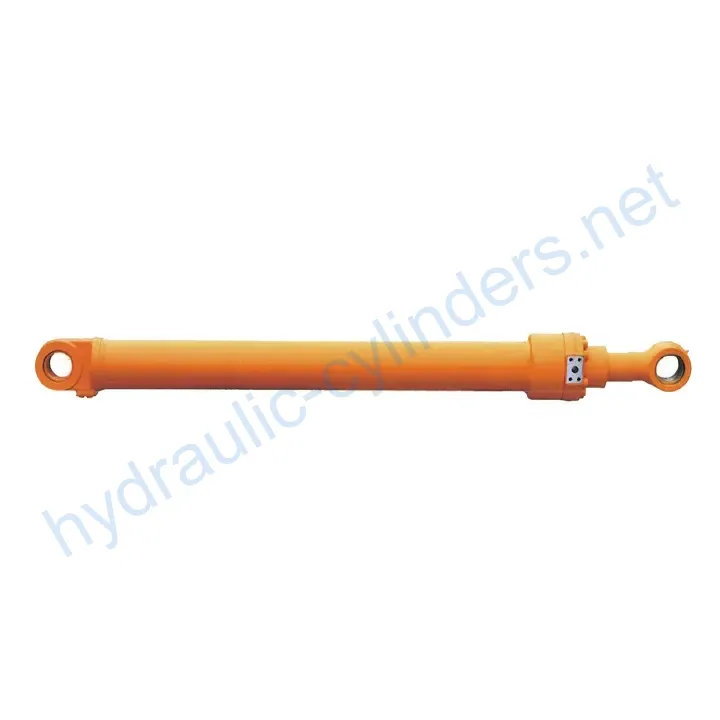Arm Cylinder For Lishide Large Excavator SC760.8
Arm Cylinder For Lishide Large Excavator SC760.8
Definition
The arm cylinder is a specially designed hydraulic cylinder that is used to provide linear motion and power to the arm of various machinery, such as excavators, cranes, and robotic arms. The arm cylinder plays a crucial role in hydraulic systems, allowing for effective movement and control of additional tools or attachments. These cylinders not only enable smooth motion but also have the ability to withstand heavy loads, ensuring efficient operation and reliability of the machinery under various working conditions.

Features
- High-Efficiency Transmission: The arm cylinder provides powerful linear motion and force, ensuring high-performance capabilities for the mechanical arm in various operations.
- Precise Control: Through the hydraulic system, the arm cylinder enables precise motion control, making the operation of additional tools more flexible and accurate.
- Durability: Arm cylinders are typically made from high-strength materials, offering excellent wear and corrosion resistance, making them suitable for long-term usage in harsh environments.
- Multi-functional Adaptability: These cylinders can be widely used in various machinery equipment, such as excavators, cranes, and robotic arms, adapting to different job requirements.
- Easy Maintenance: Designed with ease of maintenance and replacement in mind, regular inspections and upkeep are made convenient, reducing equipment downtime.

Applications
- Construction Engineering: In excavators and cranes, the arm cylinder controls the movement of buckets or booms for earthwork, material handling, and structural installation.
- Manufacturing Industry: In automated production lines, the arm cylinder is used for the motion of robotic arms during assembly, welding, and material handling processes, improving production efficiency and precision.
- Agricultural Machinery: In agricultural equipment such as harvesters and seeders, the arm cylinder controls the movement of operating arms for tasks like planting, fertilizing, and harvesting.
- Mining: In mining equipment, the arm cylinder operates the arm movement for mining and transporting ores.
- Logistics and Transportation: In forklifts and handling robots, the arm cylinder controls the lifting and movement of forks, facilitating material handling and stacking.
Design Considerations and Selection Criteria
- Load-Bearing Capacity: The arm cylinder’s ability to withstand various loads and forces is crucial for safe and efficient operation.
- Sealing: Using various seals, such as piston seals and rod seals, made of wear-resistant materials like polyurethane and nitrile rubber, ensures effective sealing performance.
- Durability: The cylinder body and threaded ends are precisely processed to enhance wear resistance, while regular lubrication with hydraulic oil is essential for proper functioning.
- Safety: Safety measures must be considered during the design to prevent accidents and ensure the protection of operators and surrounding environments.
- Maintainability: The arm cylinder design should facilitate easy maintenance and servicing, reducing downtime and optimizing overall productivity.

Sealing and Lubrication
The arm cylinder utilizes various sealing components, such as piston seals and rod seals, made from wear-resistant materials like polyurethane and nitrile rubber. The cylinder body and threaded ends undergo precise processing to improve wear resistance. Regular lubrication with an appropriate amount of hydraulic oil is necessary to ensure smooth operation and longevity of the cylinder.
Regular Inspection and Preventative Maintenance
- Regularly inspect the arm cylinder for any signs of damage, wear, or leaks.
- Check and replace seals or other worn-out components as needed.
- Ensure proper lubrication to minimize friction and wear.
- Perform preventative maintenance tasks according to the manufacturer’s recommendations.
- Keep records of maintenance activities and inspections for future reference.
Product Installation Guide
Proper installation of the arm cylinder is crucial for its optimal performance and longevity. Follow these steps:
- Carefully read and understand the manufacturer’s installation instructions.
- Prepare the necessary tools and equipment for installation.
- Ensure the equipment is powered off and in a safe condition before starting the installation.
- Remove any old or damaged cylinders, following proper safety procedures.
- Place the new arm cylinder in the correct position and align it with the mounting points.
- Securely fasten the cylinder using appropriate bolts or fasteners.
- Check that all connections are properly sealed and tighten if necessary.
- Inspect the installation for any abnormalities or misalignments.
- Test the arm cylinder’s functionality before resuming normal operation.

Safety Considerations and Environmental Factors
When using the arm cylinder, it is essential to prioritize safety measures to prevent accidents and ensure the well-being of operators and the surrounding environment. Implement safety protocols such as proper training, equipment inspections, and adherence to safety guidelines while operating machinery with the arm cylinder.
Troubleshooting and Common Issues
When encountering issues with the arm cylinder, refer to the following common problems and potential solutions:
- Problem: Leakage from the cylinder.
Solution: Inspect and replace worn-out seals or other damaged components. Ensure proper sealing and lubrication. - Problem: Irregular or jerky movement of the arm.
Solution: Check for any obstructions or misalignments. Lubricate moving parts and ensure proper hydraulic pressure. - Problem: Excessive noise during operation.
Solution: Inspect for loose or damaged components. Tighten connections and replace worn-out parts if necessary.
By following these troubleshooting tips, readers can effectively diagnose and resolve issues with their arm cylinders, as well as implement preventative measures to minimize potential problems.

Remember to logically organize the article, use subheadings for easy navigation, incorporate relevant images or charts to enhance understanding, and ensure content is clear, concise, and suitable for readers with varying levels of technical knowledge.
Author: lyl


参观我们的 VR 工厂
通过以下方式参观我们的 VR 工厂
液压缸应用:


